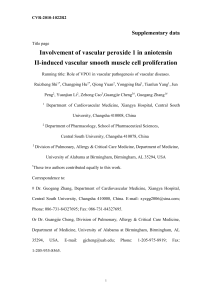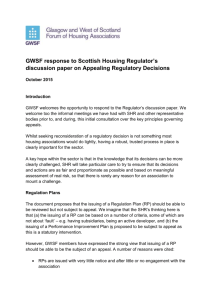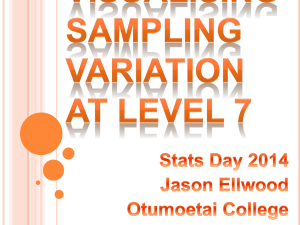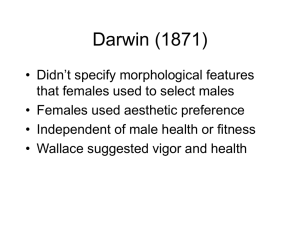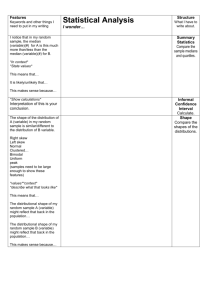Supplementary materials Posterior estimates of individual
advertisement
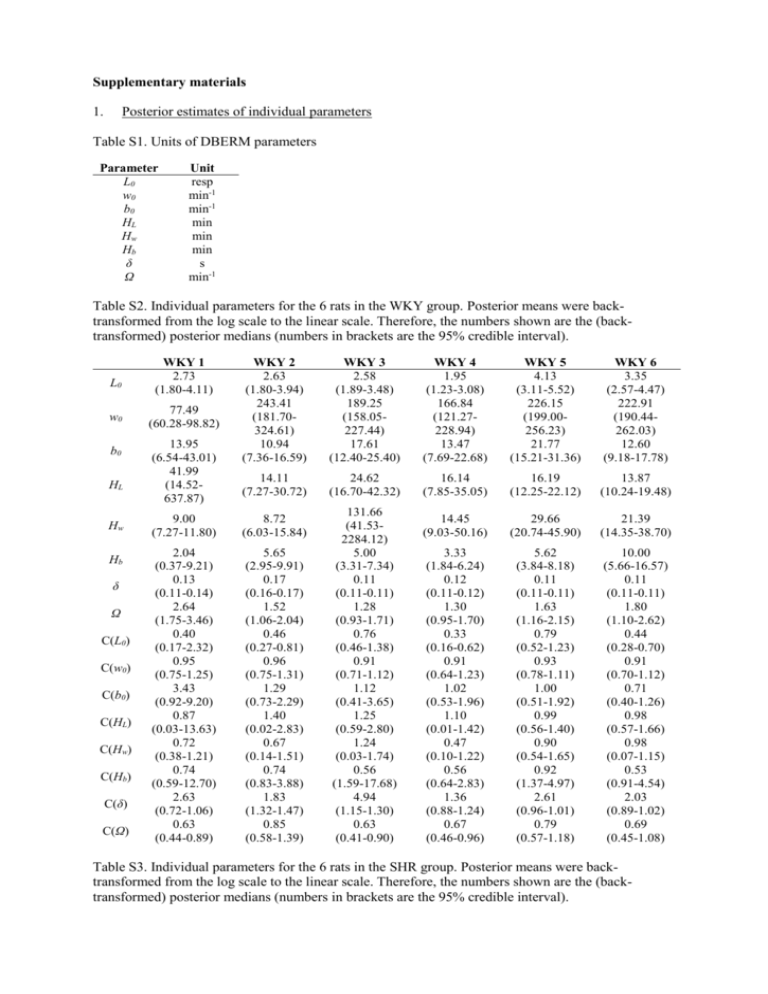
Supplementary materials 1. Posterior estimates of individual parameters Table S1. Units of DBERM parameters Parameter L0 w0 b0 HL Hw Hb δ Ω Unit resp min-1 min-1 min min min s min-1 Table S2. Individual parameters for the 6 rats in the WKY group. Posterior means were backtransformed from the log scale to the linear scale. Therefore, the numbers shown are the (backtransformed) posterior medians (numbers in brackets are the 95% credible interval). L0 w0 b0 HL Hw Hb δ Ω C(L0) C(w0) C(b0) C(HL) C(Hw) C(Hb) C(δ) C(Ω) WKY 1 2.73 (1.80-4.11) 77.49 (60.28-98.82) 13.95 (6.54-43.01) 41.99 (14.52637.87) WKY 2 2.63 (1.80-3.94) 243.41 (181.70324.61) 10.94 (7.36-16.59) WKY 3 2.58 (1.89-3.48) 189.25 (158.05227.44) 17.61 (12.40-25.40) WKY 4 1.95 (1.23-3.08) 166.84 (121.27228.94) 13.47 (7.69-22.68) WKY 5 4.13 (3.11-5.52) 226.15 (199.00256.23) 21.77 (15.21-31.36) WKY 6 3.35 (2.57-4.47) 222.91 (190.44262.03) 12.60 (9.18-17.78) 14.11 (7.27-30.72) 24.62 (16.70-42.32) 16.14 (7.85-35.05) 16.19 (12.25-22.12) 13.87 (10.24-19.48) 14.45 (9.03-50.16) 29.66 (20.74-45.90) 21.39 (14.35-38.70) 3.33 (1.84-6.24) 0.12 (0.11-0.12) 1.30 (0.95-1.70) 0.33 (0.16-0.62) 0.91 (0.64-1.23) 1.02 (0.53-1.96) 1.10 (0.01-1.42) 0.47 (0.10-1.22) 0.56 (0.64-2.83) 1.36 (0.88-1.24) 0.67 (0.46-0.96) 5.62 (3.84-8.18) 0.11 (0.11-0.11) 1.63 (1.16-2.15) 0.79 (0.52-1.23) 0.93 (0.78-1.11) 1.00 (0.51-1.92) 0.99 (0.56-1.40) 0.90 (0.54-1.65) 0.92 (1.37-4.97) 2.61 (0.96-1.01) 0.79 (0.57-1.18) 10.00 (5.66-16.57) 0.11 (0.11-0.11) 1.80 (1.10-2.62) 0.44 (0.28-0.70) 0.91 (0.70-1.12) 0.71 (0.40-1.26) 0.98 (0.57-1.66) 0.98 (0.07-1.15) 0.53 (0.91-4.54) 2.03 (0.89-1.02) 0.69 (0.45-1.08) 9.00 (7.27-11.80) 8.72 (6.03-15.84) 2.04 (0.37-9.21) 0.13 (0.11-0.14) 2.64 (1.75-3.46) 0.40 (0.17-2.32) 0.95 (0.75-1.25) 3.43 (0.92-9.20) 0.87 (0.03-13.63) 0.72 (0.38-1.21) 0.74 (0.59-12.70) 2.63 (0.72-1.06) 0.63 (0.44-0.89) 5.65 (2.95-9.91) 0.17 (0.16-0.17) 1.52 (1.06-2.04) 0.46 (0.27-0.81) 0.96 (0.75-1.31) 1.29 (0.73-2.29) 1.40 (0.02-2.83) 0.67 (0.14-1.51) 0.74 (0.83-3.88) 1.83 (1.32-1.47) 0.85 (0.58-1.39) 131.66 (41.532284.12) 5.00 (3.31-7.34) 0.11 (0.11-0.11) 1.28 (0.93-1.71) 0.76 (0.46-1.38) 0.91 (0.71-1.12) 1.12 (0.41-3.65) 1.25 (0.59-2.80) 1.24 (0.03-1.74) 0.56 (1.59-17.68) 4.94 (1.15-1.30) 0.63 (0.41-0.90) Table S3. Individual parameters for the 6 rats in the SHR group. Posterior means were backtransformed from the log scale to the linear scale. Therefore, the numbers shown are the (backtransformed) posterior medians (numbers in brackets are the 95% credible interval). SHR 1 0.47 (0.36-0.65) 351.24 (258.53480.14) 34.16 (26.74-44.23) 4017.92 (42.392.41×106) L0 w0 b0 HL 38.50 (21.57-93.57) Hw Hb δ Ω C(L0) C(w0) C(b0) C(HL) C(Hw) C(Hb) C(δ) C(Ω) 2. 5.47 (3.93-7.47) 0.11 (0.11-0.11) 3.21 (2.51-3.97) 1.51 (1.03-2.19) 0.62 (0.35-0.97) 0.61 (0.38-0.84) 0.44 (0.00-731.64) 1.55 (0.73-3.74) 1.82 (1.13-2.80) 1.00 (0.97-1.00) 0.36 (0.26-0.50) SHR 2 0.98 (0.82-1.22) 297.99 (256.22351.87) 27.92 (23.53-33.46) 1626.86 (81.776.49×105) 317.87 (87.037723.90) 14.42 (9.05-22.18) 0.11 (0.11-0.11) 5.25 (2.65-7.71) 1.49 (1.04-2.12) 0.75 (0.59-0.96) 0.73 (0.55-0.94) 47.93 (2.031.87×104) 1.82 (0.22-10.00) 2.49 (1.57-3.94) 1.00 (0.98-1.00) 0.40 (0.27-0.76) SHR 3 1.74 (1.33-2.44) 125.33 (101.66154.88) 39.80 (32.19-48.62) 2001.86 (70.417.94×105) SHR 4 2.72 (1.49-5.17) 95.74 (83.43110.95) 63.81 (47.22-83.32) 4249.27 (62.111.94×106) SHR 5 0.29 (0.19-0.43) 240.07 (140.26382.09) 43.25 (37.36-49.92) 5400.15 (60.072.16×106) SHR 6 0.96 (0.83-1.13) 898.68 (769.831047.51) 67.41 (57.98-78.29) 1653.46 (87.115.86×105) 45.44 (30.08-78.45) 15.21 (12.43-19.47) 18.25 (10.16-46.38) 39.42 (28.54-59.16) 8.18 (6.53-10.30) 0.11 (0.11-0.11) 2.12 (1.38-3.03) 1.56 (0.94-2.72) 1.10 (0.77-1.57) 0.79 (0.58-1.12) 39.52 (0.022.69×104) 4.35 (1.99-9.00) 2.76 (2.05-3.75) 1.00 (0.98-1.00) 0.33 (0.20-0.49) 5.82 (4.30-7.50) 0.11 (0.11-0.11) 2.03 (1.32-2.88) 1.41 (0.72-2.67) 0.70 (0.55-0.88) 0.76 (0.53-1.11) 1.62 (0.002152.52) 0.82 (0.58-1.14) 5.08 (3.40-7.50) 1.00 (0.97-1.00) 0.35 (0.23-0.54) 8.04 (7.08-9.11) 0.11 (0.11-0.11) 0.56 (0.22-1.06) 1.96 (1.19-3.34) 1.16 (0.70-2.24) 0.71 (0.56-0.88) 0.79 (0.001093.19) 2.01 (1.06-5.18) 1.84 (1.53-2.21) 1.00 (0.98-1.04) 0.43 (0.26-1.20) 7.28 (6.03-8.78) 0.11 (0.11-0.11) 4.34 (3.26-5.45) 0.91 (0.66-1.26) 0.91 (0.69-1.22) 0.78 (0.64-0.97) 70.39 (3.162.48×104) 2.65 (1.52-4.58) 1.14 (0.91-1.43) 1.00 (0.99-1.00) 0.36 (0.24-0.51) Posterior estimates of individual parameters It is possible that, with the low L0 of the SHR group, there were very few within-bout responses and as a result, the parameters associated with the within-bout state cannot be estimated with high levels of precision. Note that the converse can also be true – with a very high L0 there can be too few bout initiations for the parameters associated with the bout-initiation state to be estimated accurately. We tested whether the low L0 of SHR was able to detect a faster decrease in Lt (i.e., higher γ and thus lower HL) with reasonable precision and no bias by conducting the following Monte Carlo experiment. The posterior estimates of the DBERM parameters for individual subjects from EXT1 were retrieved. The γ of the 6 SHR rats was substituted with the γ of the 6 WKY rats. Which SHR rat had the γ of which WKY rat was randomly assigned without replacement. Thus, this new simulated group of 6 rats had WKY’s fast γ (and thus short HL) and SHR’s low L0 (and all other SHR rats’ parameters). Then, a Monte Carlo simulation of IRTs on EXT1 was generated for each rat using the same method as the posterior predictive check simulation outlined in the paper. The same Bayesian hierarchical analysis used in the paper was used to estimate this new group’s DBERM parameters. The resultant back-transformed group median estimates were compared to SHR’s EXT1 group medians, except for HL, which was compared to WKY’s EXT1 group median. Results in Table S4 show that (1) there was no bias in any of the group median estimates, evidenced by the 95% credible intervals of the simulated medians covering the original medians, (2) despite the low L0, the Bayesian analysis was able to estimate HL with reasonable precision (width of 95% CI) relative to the original estimate for WKY (whose 95% CI is 9.35 – 55.72, see Table 1 in paper). Table S4. Short HL can be detected despite low L0. Numbers in parenthesis are the 95% credible interval. Original medians are from Table 1 in the paper. Parameter L0 w0 b0 HL Hw Hb δ Ω Original group median 0.91 (SHR) 253.71 (SHR) 43.74 (SHR) 19.37 (WKY) 42.94 (SHR) 7.77 (SHR) 0.11 (SHR) 2.37 Median estimate of simulation 1.17 (0.30 – 4.93) 268.40 (88.36 – 812.92) 40.10 (26.18 – 62.10) 14.35 (7.57 – 27.88) 50.72 (16.27 – 830.51) 8.63 (5.34 – 14.50) 0.11 (0.11 – 0.11) 1.44 (0.10 – 8.99) We further tested whether an even lower L0 would affect the precision with which HL could be estimated. We took the same 6 simulated rats as above (with posterior means of SHR rats except for HL which was from WKY rats). We lowered each rat’s L0 by multiplying them by e-1 (0.36). The Monte Carlo IRT simulation and Bayesian hierarchical analysis was repeated. The reference group median for L0, originally from the SHR group, was also multiplied by 0.36 to reflect the change. The resultant “original median” for L0 was thus lowered to 0.33, i.e., one within-bout response for every three bout initiation responses. Results in Table S5 show that (1) there was no bias in any of the estimates of group medians, (2) estimate of HL still has reasonable precision. This shows that estimate of HL and its precision are relatively unaffected by very low L0, suggesting that the long HL estimate of the SHR group in the paper was not due to L0 being too low. Interestingly, a very low L0 reduced the precision Hw estimates. This is because there were very few within-bout responses to begin with, and because bout length declined early in the session, there was almost no within-bout response data late in the session for Hw to be accurately estimated, and therefore the data were consistent with a wide range of Hw values. Note however that despite this lack of precision, there was no bias in the estimate of Hw, and that the 95% covered the original median. Table S5. Low HL can be detected despite very low L0. Numbers in parenthesis are the 95% credible interval. Original medians are from Table 1 in paper except that for L0. Parameter L0 w0 b0 HL Hw Hb δ Ω Original group median 0.33 (Lowered) 253.71 (SHR) 43.74 (SHR) 19.37 (WKY) 42.94 (SHR) 7.77 (SHR) 0.11 (SHR) 2.37 (SHR) Median estimate of simulation 0.31 (0.14 – 0.61) 265.36 (112.21 – 597.18) 45.97 (29.05 – 72.44) 13.75 (5.53 – 42.54) 895.49 (16.17 – 9.18×105) 7.40 (4.59 – 12.43) 0.11 (0.11 – 0.11) 2.32 (0.50 – 8.84) 3. Log survivor plots of IRTs. Figure S1. Log survivor plots of IRTs from 4 different extinction periods from individual WKY rats. Dots show data, while the predicted log survival probabilities as generated using Monte Carlo simulation using samples of the posterior estimates of DBERM parameters are shown as solid line (median) and broken lines (central 95 percentile). The number of observed IRTs contained in each period is also shown. Figure S2. Log survivor plots of IRTs from 4 different extinction periods from individual SHR rats. Dots show data, while the predicted log survival probabilities as generated using Monte Carlo simulation using samples of the posterior estimates of DBERM parameters are shown as solid line (median) and broken lines (central 95 percentile). The number of observed IRTs contained in each period is also shown. 4. Current data analysis compared to Cheung et al [19]. A previous paper by Cheung et al [19] references the current data set for illustrative purposes. The results presented there are the same, except that [19] only examined EXT1, the lower bounds for parameter estimates were set to e-15 for [19] and e-20 for the current paper. Despite the difference in lower bounds, parameter estimate of EXT1 agreed between the two analyses – all of the median DBERM parameters of EXT1 in this paper lie within the 95% CI of [19] (see their Table 4), and vice versa. Both papers also found the same effect of strain on EXT1. However, the median estimates (and their 95% CI) are not identical because (1) lower bounds are different, and (2) the stochastic nature of MCMC means that parameter estimates will differ slightly between analyses on the same data set even with the exact same priors and model. The magnitude of this difference will decrease to zero as the number of MCMC samples used tends to infinity.
